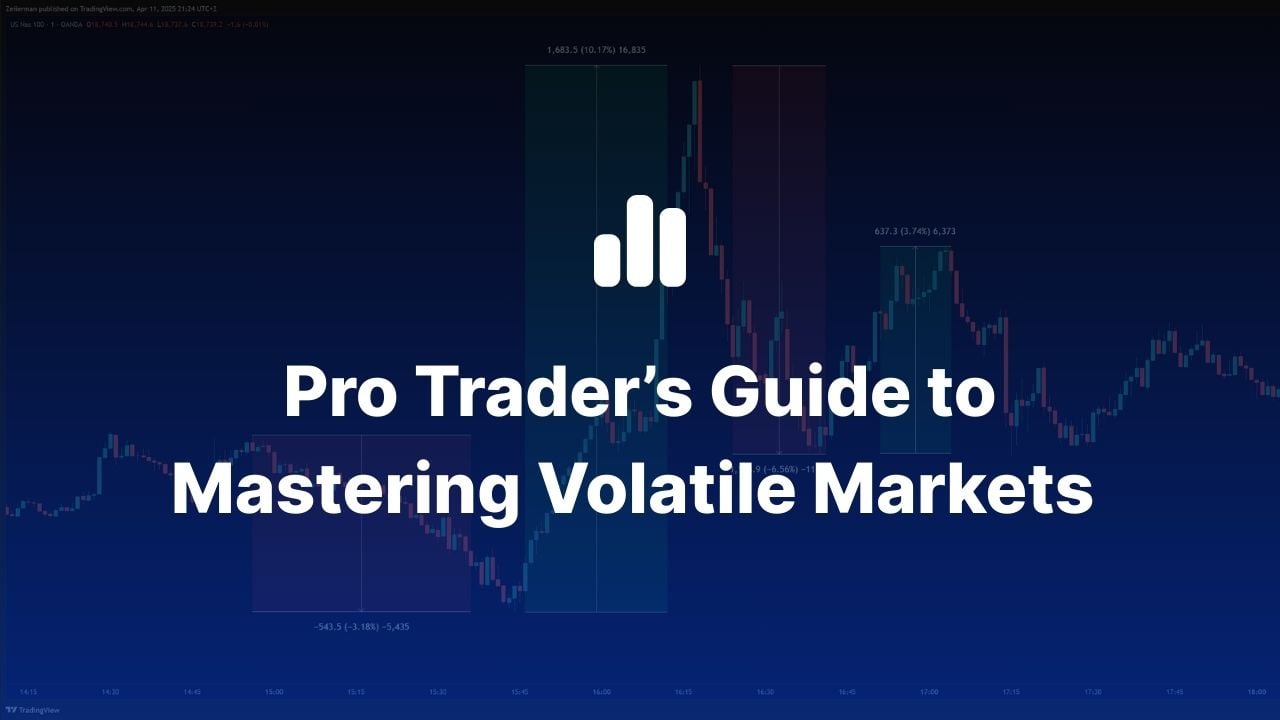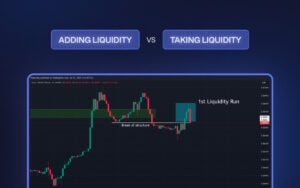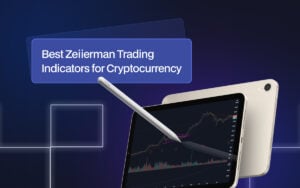Since the introduction of Trump’s “reciprocal tariffs,” NASDAQ has posted multiple 300–500 point intraday moves, gold has spiked over 5% in a single session, and even traditionally stable assets like USD/JPY have experienced flash moves of 150+ pips in minutes.
This environment presents both massive opportunity—and massive risk for retail traders. Trillions of dollars have been lost in a few days, but someone wise once said that millionaires are made in a recession.
In this guide, I will break down the exact approach professional traders, including Zeiierman and I use to navigate volatile markets confidently. Yes, I will teach you the holy grail of trading: how to trade in volatile markets and get profit during wild price swings.
I’ll cover four key areas: position sizing, liquidity management, patience, and trend-following. These aren’t theories pulled from outdated trading books. These are real strategies we have used time and again to work in chaotic markets.
Strategy 1: Reduce Position Size
Volatility is like rocket fuel. It can either launch your account—or blow it up. The key difference lies in how well you manage your exposure.
Professional traders don’t survive chaotic markets by being aggressive. We survive by being adaptive. And the very first thing to adapt to in a volatile environment is the position size.
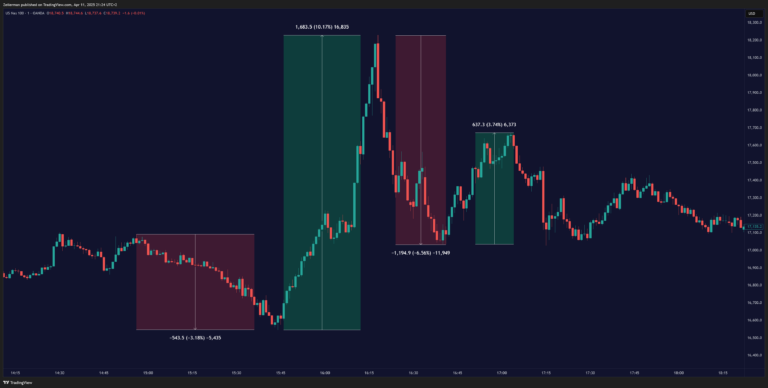
Let’s say you risk $1,000 per trade. That might mean entering with five contracts in a calm market because the average price swing is small. But in a volatile market where price swings are 4–5x larger, using the same size exposes you to catastrophic losses.
If you’re trading NAS100 futures and each point is worth $10:
- In a stable market, the daily range might be 100 points. That means a bad trade could cost you $1,000 with 1 contract.
- The same chart can swing 500 points in under 30 minutes in a volatile market. That same contract now risks $5,000+ in minutes.
This is why pros reduce position size in volatile conditions—to keep the dollar risk the same. You’re not being timid; you’re being smart.
Paul Tudor Jones, one of the greatest traders of all time, once said:
“Don’t focus on making money. Focus on protecting what you have.”
He’s referring to capital preservation, which starts with managing how much of your capital is exposed per trade. When volatility surges, you shrink the size and let the price movement do the work.
How to Adjust Your Position Size
- Measure the ATR (Average True Range) of your asset
- Determine your max dollar risk (e.g., $500/trade)
- Divide $500 by (ATR × value per point) to get your optimal size
This keeps your risk fixed, even as the market goes wild.
Volatile markets don’t require a bigger size to make more money. The market is already giving you wider ranges. The edge lies in not overexposing yourself. Trade smaller. Stay alive.
Let volatility work for you, not against you.
Bottom Line: The average move per trade increases dramatically when volatility spikes. If your position size remains the same, your risk exposure can balloon without you realizing it.
Strategy 2: Trade With Market Liquidity In Mind
Liquidity is the silent architect of every major move in the market, especially during periods of heightened volatility. It determines whether a trade executes smoothly or causes slippage, whether a breakout is clean or a trap, and whether price action is predictable or chaotic.
Yet most traders—especially beginners—mistake volume for liquidity. They are not the same.
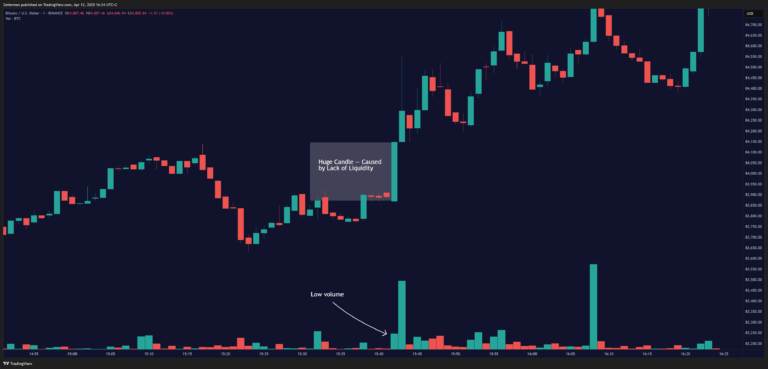
What is liquidity, and why does it matter?
Liquidity refers to the ability to enter or exit a position without significantly affecting the asset’s price.
A highly liquid market means your orders get filled close to your intended price. In contrast, low liquidity can cause price gaps, slippage, and messy execution.
When liquidity is thin:
- Bid/ask spreads widen.
- Order books get shallower.
- Even small trades can cause large price spikes.
- Execution quality drops.
How is liquidity in volatile markets?
Volatility doesn’t just cause prices to move fast. It often causes liquidity to vanish. Market makers pull back. Limit orders get canceled. Suddenly, that tidy support level becomes a minefield.
Picture this, you’re watching Bitcoin hover at a support level of $84,000. A normal bounce is expected. But the order book is thin. One large sell order sends the price crashing through $82,500. Retail traders panic and dump their positions. Price slingshots back to $84,000. What happened? Thin liquidity magnified the price move.
READ: How to Trade in Volatile Markets? 4 Crucial Investment Strategies by ProsHigh Volume ≠ High Liquidity
Traders often confuse the two. Here’s why they’re different:
- Volume is the number of transactions.
- Liquidity is the market’s ability to absorb those transactions without major price changes.
In other words, a market can show big volume bars but still be illiquid if that Volume comes from forced selling or thin order books.
You might see a massive candle and think, “Wow, that’s high volume, time to trade.” But that volume could have come from one or two aggressive market orders that swept through a thin book.
There was no one on the other side. The price moved because there was no liquidity, not because there was lots of interest.
Strategies to Handle Low Liquidity Like a Pro
1) Expect Crazy Moves — Levels Will Get Violated
In high-volatility, low-liquidity markets:
- Support and resistance levels won’t hold as they usually do.
- Price will blow through key levels like they were nothing.
- Fakeouts become extremely common.
2) Don’t Rely Solely on Support & Resistance
As a newer trader, it’s vital not to blindly rely on S/R levels in these markets. Here’s why:
- Don’t expect clean bounces or perfect reactions.
- Fakeouts, wicks, and stop hunts are normal.
- Tight stops right behind these levels? You’ll get stopped out a lot.
Experienced traders know this, so we adapt the strategies to handle the market’s unpredictability.
Matter of fact, you should make good use of our Reversal Algo indicator on TradingView.
3) Split Your Orders Into Smaller Chunks
One of the most effective techniques in volatile markets is order splitting.
Break it into smaller chunks instead of entering your full position at one price.
This would help you survive fakeouts, scale better across larger price moves, and avoid becoming liquidity for bigger players.
Example: Let’s say you want to go long at support (15,000 on the NAS100). Instead of entering all at 15,000:
- 25% at 15,000
- 25% at 14,950
- 25% at 14,900
- 25% at 14,850
This way, if the market fakes out below support due to low liquidity, you get filled at better prices without panic. Use this indicator on TradingView to Average Dow your position and keep track of your entries and the breakeven point.
4) Control Your Emotions — Understand the Environment
This is HUGE in volatile markets.
Many retail traders panic when prices move against them quickly. But if you understand the nature of low liquidity, you can remain calm:
- It’s normal for the price to move wildly.
- Levels will get swept.
- Fake moves are common before the market plays out the right way.
Bottom Line: Liquidity is like oxygen—nobody notices until it’s gone. Understanding liquidity separates traders who get wicked out in volatile markets from those who patiently wait for the trap to spring and strike when it matters.
Trade like a professional: don’t chase Volume. Read the liquidity, adjust your execution, and stay one step ahead of the crowd.
Strategy 3: Practice Patience Over FOMO
If volatility is the visible enemy in trading, FOMO is the invisible one. And in volatile markets, FOMO hits harder than usual.
Wild breakouts, vertical green candles, and sudden reversals play tricks on your mind, whispering, “You’re missing it. Get in now.” That’s exactly how you get trapped.
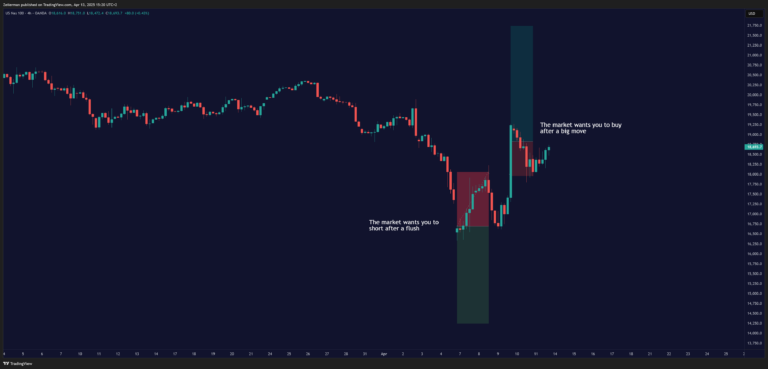
The markets thrive on emotion. In chaotic conditions, the market wants you to overreact. It wants you to chase. It wants you to be the liquidity.
Here’s the harsh truth: Most explosive moves trap the impatient.
Think back to any aggressive breakout in the NAS100 or BTC—how often does the first move lead to sustained continuation? Rarely.
More often, the breakout becomes a fakeout. The price rips through a level, retail piles in, and then boom—stop hunt, pullback, or full reversal.
How pro traders handle FOMO differently
1. They Know the First Move Is Usually the Wrong One
- Breakout? Expect a fakeout.
- Breakdown? Watch for a trap.
- New highs? Often, stop hunts.
- New lows? Often, bear traps.
Professionals understand the game. They’re not looking to predict the price. They’re looking for traps to spring—and then they attack once the dust settles.
2. They Let the Market Come to Them
We often use a saying in our community: “If it ran without you, it wasn’t your trade.”
That one sentence can save your account.
Chasing every move isn’t just exhausting—it’s account draining. Pros wait for retests, liquidity sweeps, or confirmation candles to get in with the edge.
3. They Redefine Winning
You win by following your setup, not by catching every move. Trading is not about “being right.” It’s about trading your plan. Missed the move? Good. That means you avoided the trap.
4. They Turn FOMO Into Confidence
Instead of thinking, “I should’ve gotten in,” pros say:
- “That wasn’t my trade.”
- “Let them chase—I’ll catch the pullback.”
- “No confirmation, no entry.”
You don’t always need to be in a trade. Sometimes, your biggest wins come from the trades you didn’t take.
Bottom Line: Volatility feeds on emotion, and FOMO is the market’s bait. Professionals know this. They wait for the setup to come to them. Patience isn’t passive—it’s a competitive edge.
If you ever feel compelled to make an emotional purchase, return to your “trading plan” immediately. It’ll keep you grounded in objectivity. Make good use of free scripts and indicators on TradingView to analyze the market.
READ: How to stop overtrading?Strategy 4: The Trend Is Your Best Friend
In volatile markets, nothing stretches further than a trend. And nothing punishes harder than fighting it.
Volatility amplifies trends because liquidity is thin. Breakouts don’t just run 1–2%. They stretch 10–15%. Pullbacks aren’t 10 pips—they’re 100+. If you’re trying to short highs or buy bottoms in this environment, you’re not trading—you’re gambling.
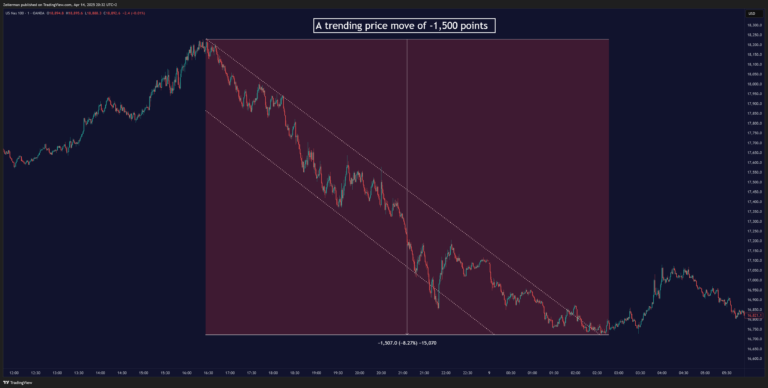
When markets are wild, mean-reversion fails more often. Traditional indicators like RSI or MACD will flash “overbought” or “oversold” before the price slows. You might see five RSI divergences on a Nasdaq chart, yet the price keeps ripping.
Why? Because in volatility + low liquidity, trends don’t just happen—they overextend.
Legendary trader Jesse Livermore said it best:
“The big money is not in the buying and the selling… but in the waiting.”
He wasn’t talking about waiting for reversals. He was talking about staying with the trend.
So, here’s how pros ride the trend in wild markets:
1. Identify the Core Direction
We look at:
- Higher highs/higher lows (uptrend)
- Lower highs/lower lows (downtrend)
- Moving Averages: Price holding above the 20 or 50 EMA.
- Volume + Structure: Breakouts on strength, pullbacks on weakness.
Example: S&P 500 is breaking through a key resistance zone with volume. Instead of shorting, you mark the breakout zone and wait for a retest. You’re not the early buyer—you’re the smart buyer.
2. Wait for Countertrend Moves to Rejoin the Trend
Retail traders panic during pullbacks. Pros love them. A 5% dip in an uptrend is a discounted entry—not a sign to short.
Think of trends like waves. Every pullback is the wave resetting to build the next surge.
3. Ignore What Indicators Say—Trust Structure
In volatile trends, indicators lag. Price action leads.
Example: Bitcoin RSI sits above 70 for days while price rallies from $25,000 to $32,000. Every divergence says “short.” Price says, “Not yet.”
Pros wait for the price structure to break before considering going against the trend. Until then? Ride the wave.
READ: A Beginner’s Guide to Overleveraging in Trading4. Don’t Try to Predict Tops or Bottoms
Catching a top in a volatile trend is a great way to blow up your account. Professionals aren’t in the prediction business—they’re in the reaction business.
They follow the trend. They add on pullbacks. They get out when the structure breaks.
We made an entire Trend & Pullback toolkit to help you understand the current trend, market momentum, and possible pullbacks.
Bottom Line: In volatile conditions, trends stretch. Don’t fade them—follow them. Catch the meat of the move and let the rest go. That’s how pros trade chaotic markets without getting chopped to pieces.
Conclusion: Thriving in Chaos Requires Strategy
Volatile markets are not for the faint of heart. The wild swings, liquidity gaps, and emotional traps can rattle even seasoned traders. But for those who know how to adapt, they can be a goldmine.
The strategies we covered in this guide aren’t theories—they’re battle-tested mission plans we use every time market gets wobbly:
- Reduce your position size when volatility spikes. Let the range work for you, not against you.
- Understand liquidity and how its disappearance can warp price movement. Anticipate traps instead of falling into them.
- Master patience. FOMO is a psychological landmine. The best trades are the ones that come to you—not the ones you chase.
- Follow the trend, especially in chaos. Volatility amplifies trends. Fighting them is expensive. Riding them is profitable.
At Zeiierman Trading, we believe that success comes from a mix of technical execution and psychological resilience. If you want to develop both, you’re already on the right path.
👉 Ready to take the next step? Join our trading community on Discord, explore our TradingView indicators, or subscribe to our newsletter to keep sharpening your edge.
Stay patient. Stay sharp. And above all—trade like a pro.
FAQ: Trading in Volatile Markets
1. What is the best trading strategy for volatile markets?
The best trading strategy for volatile markets prioritizes risk management, trend-following, and disciplined execution. Professional traders often reduce position sizes for increased price swings, rely on confirmed trend direction rather than attempting to time tops or bottoms, and use wider stop-losses to prevent being wicked out.
A solid strategy also includes waiting for clear setups rather than chasing every move. Combining these tactics with a strong psychological edge can help traders capitalize on volatility without being consumed.
You can use our Volatility Trend (free) and Volatility Index (invite-only) indicators on TradingView to analyse market volatility.
2. How do you manage risk in volatile markets?
Managing risk in volatile markets starts with position sizing. By reducing the size of each trade, you can maintain consistent dollar risk despite larger price fluctuations. Emotion control and sticking to a trading plan to avoid revenge trades helps prevent spiraling losses when the market becomes unpredictable.
3. How do you trade during high market volatility?
Focus on high-probability setups, use limit orders instead of market orders to control slippage, and avoid trading during low-liquidity periods.
Volatility often creates fakeouts, so waiting for confirmation before entering is crucial. Also, widen your stop-losses and reduce your size to account for unpredictable price swings.
Stay alert, manage your emotions, and never assume every big move is a valid breakout.
4. How to avoid FOMO in trading?
To avoid FOMO (Fear of Missing Out), traders must operate with a predefined plan and accept that not every move is theirs to catch. Recognizing that markets are designed to exploit emotion can help reframe impulsive urges. Repeating affirmations like “If it ran without me, it wasn’t my trade” trains discipline.
Pro traders wait for price to come into their zone, align with their setup, and only act on confirmation. FOMO fades when you realize the best trades are not the ones you chase but the ones you patiently prepare for.
5. Why is trend-following effective in volatile markets?
Trend-following is effective in volatile markets because trends often extend further and last longer when volatility and low liquidity are present. Instead of trying to pick reversals or catch every countertrend bounce, following the established direction allows traders to capture large portions of big moves.
Trend-following also reduces decision fatigue—you wait for pullbacks or breakouts to join momentum rather than fighting it. In chaotic markets, swimming with the current gives you an edge. Fighting it, on the other hand, often leads to losses.
You can follow our Trend Algo and Range & Trend indicators to follow and analyse market trends.
6. What are the best indicators for trading in volatile markets?
The best indicators for trading in volatile markets measure momentum, volatility, and trend strength. These include:
- Average True Range (ATR): Helps set volatility-based stop-loss levels.
- Moving Averages (e.g., 20 EMA or 50 EMA): Help identify trend direction and pullback zones.
- Volume Profile or VWAP: Offers insight into where institutional trading is occurring.
- Bollinger Bands: Visualizes volatility expansion and potential mean reversion zones.
- RSI or Stochastic: Useful, but should be used with caution as “overbought/oversold” signals often fail in strong trends.
These tools can help traders navigate volatile conditions with more precision and confidence.
